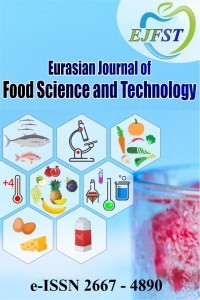Process Conditions of Table Olive Fermentation
Process Conditions of Table Olive Fermentation
Fermentation, Olive, Process, Table olive, Parameter Condition,
___
- Alak S. 2016. Gemlik tipi sele zeytini üretiminde zeytin fermentasyon sürecinin mikrobiyolojik olarak işlenmesi ve pastörizasyonun ürünün raf ömrü üzerine etkisinin araştırılması. Master Thesis T.C. Uludağ Üniversitesi, Fen Bilimleri Enstitüsü, Gıda Mühendisliği Anabilim Dalı, Bursa, Turkey.
- Anagnostopoulos D., Bozoudi D. & Tsaltas D. 2017. Yeast ecology of fermented table olives: a tool for biotechnological applications. Yeast-Industrial Applications, Intech Open, Rijeka, Croatia, 135-152.
- Aponte M., Ventorino V., Blaiotta G., Volpe G., Farina V., Avellone G., Lanza C.M. & Moschetti G. 2010. Study of green Sicilian table olive fermentations through microbiological, chemical and sensory analyses. Food Microbiology, 27. doi: https://doi.org/10.1016/j.fm.2009.09.010
- Barilacqua A., Corbo M.R. & Sinigaglia M. 2012. Selection of yeasts as starter cultures for table olives: a step by step procedure. Frontiers in Microbiology, 3, 194. doi: https://dx.doi.org/10.3389/fmicb.2012.00194
- Bautista-Gallego S., Arroge-Lopez F.N., Romero-Gil V., Rodriguez-Gomez F., Garcia-Garcia P. & Garrido-Fernandez A. 2013. Microbial stability and quality of seasoned cracked green Alorena table olives packed in diverse chloride salt mixtures. Journal of Food Protection, 76, (11). doi: https://doi.org/10.4315/0362-028X.JFP-12-504
- Bleve G., Turfariello M., Durante M., Perbellini E., Ramires F.A., Grieco F., Cappello M.S., Domenico S., Mita G., Tasioula-Margari M. & Logrieca A.F. 2014. Phsico-chemical and microbiological characterization of spontaneous fermentation of Cellina di Nardo and Leccino table olives. Frontiers in Microbiology, 5, 570. doi: https://doi.org/10.3389/fmicb.2014.00570
- Bonatsou S., Tassou C.C., Panagou E.Z. & Nychas G.J.E. 2017. Table olive fermentation using starter cultures with multifunctional potential. Microorganisms, 5, 30. https://dx.doi.org/10.3390/microorganisms5020030
- Botta C. & Cocolin L. 2012. Microbial Dynamics and biodiversity in table olive fermentation: culture-dependent and independent approaches. Frontiers in Microbiology, 3, 245. doi: https://dx.doi.org/10.3389/fmicb.2012.00245
- Borcakli M., Özay G., Alperden I., Özsan E. & Erdek Y. 1993. Changes in chemical and microbiological composition of two varieties of olive during fermentation. Grasas Aceites, 44, 4-5.
- Campus M., Sedda P., Cauli E., Piras F., Comunian R., Paba A., Paga E., Schirru S., Argioni A., Zurru R. & Bandino G. 2015. Evaluation of a single strain starter culture, a selected inoculum enrichment, and natural microflora in the processing of Tonda di Cagliari natural table olives: Impact on chemical, microbiological, sensory and texture quality: Impact on chemical, microbiological, sensory and texture quality. Food Science and Technology, 64. doi: https://dx.doi.org/10.1016/j.lwt.2015.06.019
- Yayın Aralığı: Yılda 2 Sayı
- Başlangıç: 2017
- Yayıncı: İlknur BAĞDATLI
Olive Leaf: Antimicrobial and Antioxidant Properties, Food Applications, and Current Studies
Process Conditions of Table Olive Fermentation
Impact of Temperature on the Salty Taste Perception of Reduced Salt Ayran
Investigation of Antimicrobial and Photoprotective Activity of Hylocereus undatus Methanol Extracts
Irem CELIK, Meltem ASAN-OZUSAGLAM
Determination of Microbiological Quality of Fish Burgers Enriched with Orange Peel Extract
